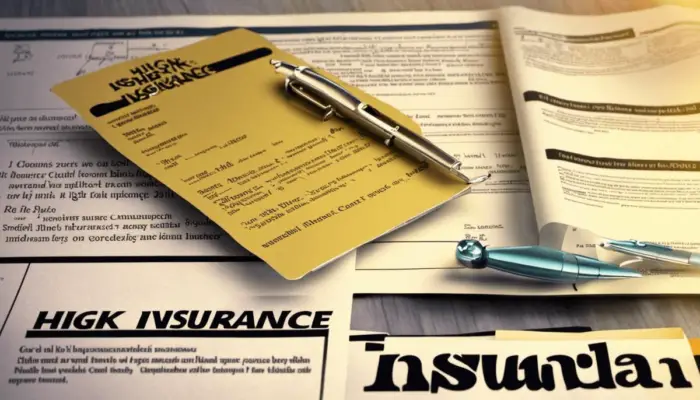In the ever-evolving landscape of the insurance industry, high-risk insurance occupies an important role.risk insuranceucial for both insurers and policyholders to have a thorough understanding of how high-risk insurance works, its duration, and the necessary path toward transitioning away from it.
This article commences with a deep dive into the core attributes of high-risk insurance, serving individuals or entities who are considered ‘high risk‘ due to various factors.
From assessing numerous types of high-risk insurance, such as auto, home, or health insurance, all nuances of this subject matter will be analyzed.
Understanding High Risk Insurance
Understanding High Risk Insurance
High-Risk Insurance is a type of insurance coverage extended to individuals or entities deemed ‘high risk’ by insurance providers.
This usually means that the insured party is more likely to file an insurance claim due to various factors, such as a history of previous claims or risky habits. Additionally, insurers may categorize individuals as ‘high risk’ based on age, medical condition, profession, or location.
Who is High Risk Insurance For?
High-risk insurance is typically for individuals or entities who cannot acquire insurance through standard methods due to their considered risk factors.
For example, young drivers, people with poor credit histories, homeowners in areas prone to natural disasters, or people with chronic diseases may all be classified as high risk by insurance companies.
Factors That Make One ‘High Risk’
Insurers consider several factors when determining whether an individual or entity is considered ‘high risk.
These can include their driving record, credit score, health status, profession, and the location of their home or property.
For example, a person with several speeding tickets could be considered a high risk to auto insurers. Similarly, homeowners living in a flood-prone area could be deemed high risk by home insurance companies.
Types of High Risk Insurance
High risk insurance can encompass several categories, including auto, health and home insurance. High risk auto insurance, for example, is often required for drivers with poor driving records or those involved in multiple accidents.
High risk health insurance, on the other hand, may apply to individuals with pre-existing health conditions or a history of certain risky behaviors. High risk home insurance is often taken out by homeowners living in areas susceptible to natural disasters such as hurricanes, floods, or wildfires.
Duration of High Risk Insurance
The duration an individual or entity remains ‘high risk’ may vary based on many factors. For example, a person convicted of drunk driving may require high-risk auto insurance for at least five years.
On the other hand, someone who has rebuilt their credit score may only need high-risk insurance until their credit improves, which can occur in months or years.
Therefore, the duration can vary significantly among different cases. One thing is universal: demonstrating responsible behavior over time can help reduce your risk level and potentially lead to less costly insurance premiums.

Duration of High Risk Insurance
Duration of High Risk Insurance
Typically, high-risk insurance lasts for three years. It’s a period determined to be sufficient in assessing and monitoring the risk behaviors or situations of the insured party.
During this time, the insurance company evaluates any potential risks and weighs them against the premium payments. However, the duration can vary depending on several factors.
Conditions That Extend or Reduce Insurance Duration
The duration of high-risk insurance can be adjusted based on specific conditions. The duration may extend when the insured party incurs further violations or accidents while under their high-risk status.
Conversely, insurers may reduce the period if the insured commits to a violation-free and safer driving record. The changes in duration are subject to the discretion of the insurance company.
Impact of Continuous Safety and Violation-Free Periods
Maintaining a clean driving record can significantly affect the duration of your high-risk insurance. A continuous period without infractions or claims demonstrates to your insurer that you are a responsible and safer driver. Consequently, this could lead to a reduction in your high-risk status and potentially lower premium fees.
State Specific Rules
The application and terms of high risk insurance can widely vary depending on your state regulations. Some states may enforce strict rules, resulting in longer high-risk periods, while others offer more lenient policies.
It’s advised to familiarize yourself with your state’s specific regulations on high-risk insurance to understand its duration and the factors that can extend or shorten it.
Exceptions
There may be exceptions to the general rules regarding high-risk insurance. For instance, some insurance programs designed for high-risk drivers could offer a shorter or longer duration than the typical three years.
Also, in certain circumstances, like severe traffic offenses or DUIs, the duration of high-risk insurance can surpass the usual length and extend to five years or more.
Knowing these specific situations and discussing them with your insurer is crucial to determine how they might affect your insurance duration and status.
Insurance companies offer programs and pathways to help high-risk drivers offset their status and strive to secure lesser-risk evaluations.

Transitioning from High Risk Insurance
Understanding High Risk Insurance
High-risk insurance, or non-standard insurance, is designed for individuals representing a higher-than-average risk for insurance companies.
Often, individuals are placed within this category due to a history of at-risk behaviors like traffic violations or involvement in accidents.
However, being labeled as high-risk is not permanent. You can transition to regular insurance after a specific period of successful risk management.
Time Frame for High Risk Insurance
High risk insurance typically lasts between three to five years. The exact duration depends on the insurance provider and individual circumstances.
The term begins at the date of the infraction that deemed you high risk, such as the date of a DUI conviction or the date an accident occurred.
Fulfilling this term without additional infractions can help transition you from high-risk to standard insurance.
Accelerating the Transition to Regular Insurance
There are several potential ways to accelerate your transition to regular insurance. First, make sure to pay all your premiums on time. Late or missed payments can extend your time as a high risk insured.
Second, drive safely. By avoiding traffic violations and accidents, you can demonstrate that you’re a responsible driver, thus reducing your risk in the eyes of insurers.
Additionally, consider taking defensive driving courses. Certification from a recognized driving school can demonstrate your commitment to safe driving, potentially earning you a discount on your insurance.
Reviewing Your Insurance Status
Lastly, regularly review your insurance status. After serving the specified term, revisit your policy and discuss with your insurer the possibility of transitioning to a standard insurance agreement.
It’s crucial to remember that not all insurance providers view risk similarly. If your provider is unwilling to shift you from a high-risk classification, consider shopping for other insurance options.
Maintaining Standard Insurance
Once you’ve transitioned to regular insurance, maintain it by demonstrating safe behavior and keeping your record clean. Regularly review your policy to ensure it matches your needs and financial situation.
Remember that avoiding risky behavior and maintaining a clean driving record are the surest ways to keep your insurance premiums low.

Conclusion
Throughout this study, it becomes evident the complexities encompassing high risk insurance and its duration. It’s vital for individuals under the umbrella of high-risk insurance to tread cautiously and maintain their safety record, as it can greatly impact their insurance, except for those state-specific rules and occasional exceptions.
Transitioning-risk risk insurance to standard insurance is not an imp but necessitates a keen understanding and predetermined actions.
Ultimately, possessing knowledge on this matter can empower policyholders to manage better their state’s high-risk risk insured as they make their way to transitioning into regular insurance.

Chris Ekai is a Risk Management expert with over 10 years of experience in the field. He has a Master’s(MSc) degree in Risk Management from University of Portsmouth and is a CPA and Finance professional. He currently works as a Content Manager at Risk Publishing, writing about Enterprise Risk Management, Business Continuity Management and Project Management.

